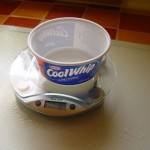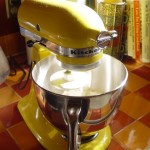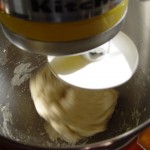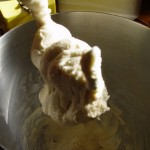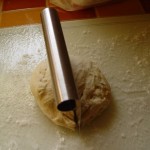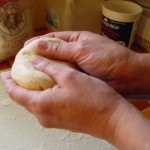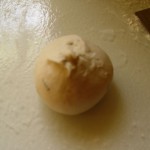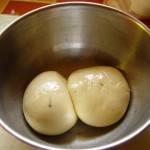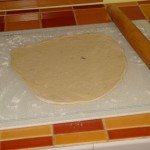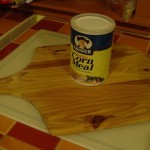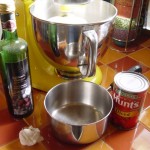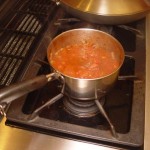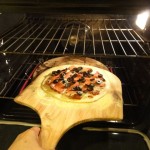Perfect Pizza
Well, perfect for me and my husband anyway, and maybe for you if you like a relatively thin, hard crust that’s a little salty, and a pizza sauce that’s definitely tangy from a generous amount of balsamic vinegar. Oh darn, now I want another one.
But first to give credit where due. This is an Alton Brown recipe and you can find it at the Food Network, but I have made a few modifications and I’ve also, through the years, figured out exact weights for the flour and water, making it much easier to reliably reproduce. The sauce, however, is more or less my own (I don’t use Alton’s red sauce recipe).
Alton’s original ingredients:
2 tablespoons sugar
1 tablespoon kosher salt*
1 tablespoon pure olive oil
3/4 cup warm water
2 cups bread flour (for bread machines)
1 teaspoon instant yeast
2 teaspoons olive oil
Olive oil, for the pizza crust
Flour, for dusting the pizza peel
Notice the asterisk? Alton says that people who find this crust too salty, should adjust the salt and sugar ratios, so here’s the adjusted recipe with weights in grams.
Amended ingredients:
1 tablespoon + 2-1/2 teaspoons sugar
1 teaspoon kosher salt
1 tablespoon pure olive oil
3/4 cup warm water (170g) (nuke it for 10-15 seconds to warm)
2 cups flour (270g)
1 teaspoon instant yeast (I use Fleischmann’s RapidRise Highly Active Yeast)
2 teaspoons olive oil (to coat the two dough balls during the rise)
Olive oil, for the pizza crust (not really necessary)
Cornmeal, for dusting the pizza peel
I’ve made this with both bread flour and all purpose flour (I now use King Arthur flour), and the bread flour does make for a chewier crust, but it’s also a lot more difficult to roll out (I’ve given up on Alton’s stretching the dough by hand because my husband likes a thin crust, which is much easier to accomplish with a rolling pin). After weighing the flour, I put it, the yeast and salt in my food processor to sift. (I put all the flour, the water, oil and sugar in mixer at once, instead of Alton’s baffling 1 cup and 1 cup directions.)
This dough takes a long time to come together, about 15 to 20 minutes at the number four setting on my 4.5 quart Kitchen Aid mixer, using the dough hook, of course. How do you know when it’s done? Well, for one thing, the dough will stick to itself more than to the mixing bowl. You can actually pinch off a piece of dough and use it pull off dough from the sides of the bowl. But the best method is to take that small piece of dough, roll it into a small ball, flatten it into a disk and stretch it out. When it’s properly kneaded, the stretched dough will make a translucent windowpane you see light shining through. And to a certain extent, you can’t even roll that little ball until the dough has come together.
Dust your work surface with flour, then with a spatula, scrape the dough out of the bowl. Again, when it has been properly kneaded, the dough will want to stick to itself. Divide the dough in half and shape two balls. You’re trying to create a smooth skin by folding the dough in on itself, stretching the dough tight. Hold the dough as shown in this picture, and then fold the dough inward several times, while pinching the folded ends together. When the ball starts to show a smooth, firm surface, turn it over and roll the dough around on the floured surface. Once you’ve done this, incidentally, that’s pretty much the shape of that pizza. If, for instance, you’ve not done a very good job of dividing the dough, it’s going to be difficult to add dough to this ball.
Put the two balls in a bowl, coating each one with olive oil to prevent them from sticking to the pan or each other, and cover with plastic wrap.
A slow rise is best (unless you’re hungry now)
You really should start making your dough the day before you plan to eat your pizza, but I can never plan that far ahead. I started my dough about noon, finished shaping the two dough balls about 1 p.m., let it rise on the kitchen counter about two hours, and then put the balls in the refrigerator until 5 p.m.. While making the sauce, I let the dough rise on the counter (I made sort of a bain marie, with my metal mixing bowl floating in a bowl filled with warm water).
Ideally the dough should be refrigerated overnight as per Alton’s instructions and when I remember to do this, the flavor’s improved.
The sauce
The pizza sauce is incredibly simple. Sautee a handful of diced white onions and a few cloves of diced garlic in a drizzle of olive oil (yes, EVOO). I suppose I could just sweat the onions and garlic, but I like a little browning. Add a 15 oz can of diced tomatoes, perhaps a tablespoon of balsamic vinegar (I rarely measure and usually do two splashes), salt and pepper to taste, and your herbs of choice, but I add chopped basil, Italian parsley, crushed red pepper flakes and dashes of McCormick’s Italian seasoning (sage, oregano, rosemary, etc.). It’s up to you whether you add more olive oil or vinegar and definitely season to taste. Simmer at least 30 minutes, but it wouldn’t hurt if you reduced some of the liquid over say an hour.
Rolling out the crust
As mentioned before, I don’t stretch the dough by hand any longer, nor do I toss it. It’s covered in too much oil to make that practical anyway. For some reason, the first pie is always unsymmetrical (my husband’s pie) and the second one is perfect (mine). I then put the crust on a pizza peel ($20 at Bed, Bath and Beyond, probably $10 at a kitchen supply store) heavily dusted with cornmeal, add my sauce, cheese and toppings, and then slide it onto the pizza stone.
My rolling pin, by the way, no longer requires dusting. I usually just rinse it off after use and it’s now been seasoned by a lot of olive oil.
At 450°, the pizza takes about 10 minutes to bake, with an additional 2 minutes with the oven set to broil. But I’ve recently switched to 500° and the oven set to roast (after preheating 30 minutes with the oven set on bake) and only eight minutes total. A pizza stone is essential and so is the cornmeal.
This recipe works perfectly in Denver at 5,280 feet. My last pizza was perfect and my husband gobbled up his entire pie with not a speck of crust left behind (it helps to use the leftover sauce for dipping).
PS I can’t swear that the weight in grams is an exact conversion for the volume measurements, but I’ve made this recipe a lot using these numbers and it’s very dependable.

